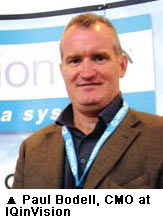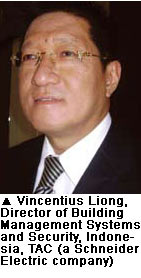Security technology has been used to monitor and conserve the environment and is now moving to cover energy-saving applications.
Security technology has been used to monitor and conserve the environment and is now moving to cover energy-saving applications.
With signs of the global recession hitting rock bottom, government s around the world are factoring energy-saving strategies into their recovery plans. According to "A Climate for Recovery: The color of stimulus goes green" survey, conducted by HSBC Global Research, an estimated US$430 billion, approximately 15 percent of proposed fiscal stimulus packages of more than 20 economies worldwide, will be invested to address climate change over the next decade. The bulk of the spending goes toward green infrastructure development, including low-carbon power, sustainable transport, energy efficiency, water treatment and pollution control.
Massive investments in the green agenda have provided ripe opportunities in a myriad of industries. Security players are encouraged to find new applications for their technology and modify products to be more environment-friendly. In addition to protecting assets and preventing crime, surveillance systems now have to help generate utility savings.
Automatic energy-saving systems ensuring efficient use of power have gained traction. "Cameras with onboard intelligence can send alerts when a door is left open, saving heating and cooling expenses," said Paul Bodell, CMO at IQinVision. Another popular application is integrated green building control, where card access triggers HVAC and lighting system coupled with chiller and boiler optimization, said Vincentius Liong, Director of Building Management Systems and Security, Indonesia, TAC (a Schneider Electric company).
 Reducing energy consumption results in sizable savings at large establishments, making industrial buildings, pharmaceutical factories, four- and five-star hotels, hypermarkets, shopping malls and critical infrastructure key verticals, Liong said. More specifically, "early adopters are typically those with systems with 25 or more outdoor cameras," added Bodell.
Reducing energy consumption results in sizable savings at large establishments, making industrial buildings, pharmaceutical factories, four- and five-star hotels, hypermarkets, shopping malls and critical infrastructure key verticals, Liong said. More specifically, "early adopters are typically those with systems with 25 or more outdoor cameras," added Bodell.
Energy-efficient Devices
Energy efficiency can simply mean taking advantage of low-power security apparatus. Honeywell and IQinVision provide cameras with low-power consumption, and Exacq's hybrid DVR ensures lower lifetime operating cost.
While general dome cameras require 30 watts or more, Honeywell's PTZ domes are operated on less than 15 watts. IQinVision's PoE cameras consume 6.5 watts, promising to save thousands of dollars a year. "With electricity costing $0.15 per kWh, 50 PoE cameras can save users $1,543 in electricity bills and reduce greenhouse gas emissions by 7.7 kg every year of operation," explained Bodell.
 Making use of renewable energy, like wind and solar power, is on the rise. By increasing solar capture by up to 40 percent, Puurgen allows its surveillance system, in need of approximately 550 kWh per year, to be fully powered by solar panels. "With low-power components, Puurgen's solar video solutions use less than a third of energy required in wired analog systems," said John Charlick, CEO of Puurgen. "Without power cabling and digging costs, the pay-back period can be as short as two years."
Making use of renewable energy, like wind and solar power, is on the rise. By increasing solar capture by up to 40 percent, Puurgen allows its surveillance system, in need of approximately 550 kWh per year, to be fully powered by solar panels. "With low-power components, Puurgen's solar video solutions use less than a third of energy required in wired analog systems," said John Charlick, CEO of Puurgen. "Without power cabling and digging costs, the pay-back period can be as short as two years."
ARINC builds self-sustained mobile surveillance towers with solar panels and wind generators. Onboard cameras and wireless communication equipment run on solar and wind-powered batteries. This off-grid solution helps secure the Indianapolis International Airport with flexible intrusion detection and perimeter protection at a low operating cost.
Lighting is another expensive necessity and accounts for a significant portion of power consumption. Today, one of every five dollars spent globally goes to lighting, estimated FLIR Systems, and much is lost through excessive and inefficient use of light. "Instead of leaving lights on to see that nothing is happening at warehouses or buildings, customers prefer thermal cameras that produce crisp images in the dark," said Christiaan Maras, Marketing Manager Eurasia, FLIR Systems. Given that a security system needs to be in operation 24/7, a 100-watt lamp is often required to run at least 12 hours a day, Maras  added. "Similar to general video solutions, thermal cameras consume 3 watts, and those installed on a pan/tilt unit can go up to 50 watts; however, there is no cost on lighting and more energy-friendly."
added. "Similar to general video solutions, thermal cameras consume 3 watts, and those installed on a pan/tilt unit can go up to 50 watts; however, there is no cost on lighting and more energy-friendly."
Energy Control
Surveillance devices used to allow for better energy control do not lack in efficiency compared to non energy-saving equipment. Green applications, therefore, of video monitoring and access control solutions have become an added appeal to customers.
Video Surveillance
Lenox Instrument, specialized in video systems for industrial applications, helps reduce fuel consumption by as much as 2 percent. Its high-temperature remote viewing system enables real-time monitoring of operational processes in boilers, furnaces, kilns and incinerators. Through regular inspections of video information, "combustion performance, manufacturing efficiency and cost savings can be realized," said Paul Lang, VP of Lenox Instrument, in a prepared statement. "This is especially true in the steel industry, where furnace performance and efficient manufacturing processes are crucial to reducing cost." Another IR solution designed by FLIR saves energy by detecting common problems of industrial furnaces, such as coking, scaling and ash build-up.
FLIR also provides IR cameras that identify greenhouse gas emissions. With the ability to trace small quantities of gas leaks, the high-resolution IR cameras protect against revenue loses and ensure workers' safety. Swift and effective scans enable wide-area coverage, improving operation efficiency and reducing power consumption.
Access Control
The idea of preserving energy with access control systems has been around for years and plays a key role in building automation. The UN "A Global Green New Deal" report shows that buildings account for 30 to 40 percent of all energy use, carbon emission and waste generation.
"A well-designed building management system (BMS) generally save users 5 to 20 percent of energy costs annually, and up to 20 to 30 percent, if the building runs  HVAC and lighting around the clock," noted Liong. Achieving roughly 35-percent savings in electricity consumption and cutting overall costs by 25 percent, TAC's BMS slashes energy bills and improves comfort. It encompasses a variety of systems: access control systems to determine building load, HVAC control, flexible lighting schedule that adjust to sunset, sunrise and daylight savings, demand-limiting and load-shedding to avoid peak-hour penalty charges, and optimized chiller/ boiler operation. "Depending on buildings, BMSs pay for themselves within a period of 12 to 60 months," Liong said. "Buildings operating 24/7 usually have a shorter payback period."
HVAC and lighting around the clock," noted Liong. Achieving roughly 35-percent savings in electricity consumption and cutting overall costs by 25 percent, TAC's BMS slashes energy bills and improves comfort. It encompasses a variety of systems: access control systems to determine building load, HVAC control, flexible lighting schedule that adjust to sunset, sunrise and daylight savings, demand-limiting and load-shedding to avoid peak-hour penalty charges, and optimized chiller/ boiler operation. "Depending on buildings, BMSs pay for themselves within a period of 12 to 60 months," Liong said. "Buildings operating 24/7 usually have a shorter payback period."
Without integration with building systems, some access control solutions serve as easy tools to manage energy consumption. Paxton Access' power-saving reader is engineered to retain an access card, where the card determines the power supply of all connected electrical equipment. Users simply insert and remove cards upon entering and leaving the room. This straightforward energy-saving concept ensures electrical equipment is used only when required.
Hundure Technology helps conserve energy via schools' lighting and HVAC systems. The access control system is configured based on class schedules, activating light and relevant equipment shortly before class begins and turning power off afterwards. To cut utility bills, only professors and staff are granted access to turn lights and HVAC on, and an audit trail is kept for future investigation of unusual situations. The system updates itself on a daily basis and verifies university timetables and readers' data every hour, preventing system failure and saving maintenance and energy cost.
Challenges
Climate change is high on today's global agenda and has already affected our way of life. Examining running cost to cut energy bills receives growing attention, spurring demand on security solutions powered by sustainable energy. What started as only government facilities and critical infrastructure utilizing solar- powered video surveillance at off-grid and remote establishments is now an area of interest in commercial and residential sectors. Large hotels and private estates are keen on using solar-powered surveillance systems to manage their security requirements, said Charlick.
powered video surveillance at off-grid and remote establishments is now an area of interest in commercial and residential sectors. Large hotels and private estates are keen on using solar-powered surveillance systems to manage their security requirements, said Charlick.
On the other hand, in a volatile economy, environmental considerations are thought of as an unaffordable extravagance by some people. "Installing BMSs for energy savings is still considered a costly solution rather than an investment," said Liong.
Also, integration with third-party systems and productivity enhancements are common obstacles, Liong added. "Central management of power meters, generator sets, fire alarms, public address systems, lighting control with PIR sensors and security systems pose challenges." The green movement is a definite trend, with the need to save energy continuing to drive the development of low-power consumption solutions.